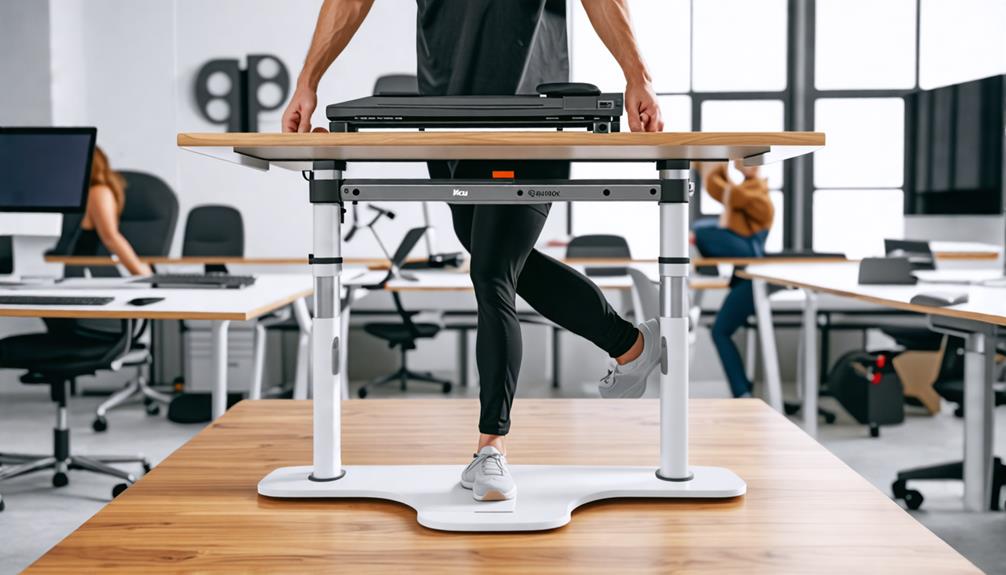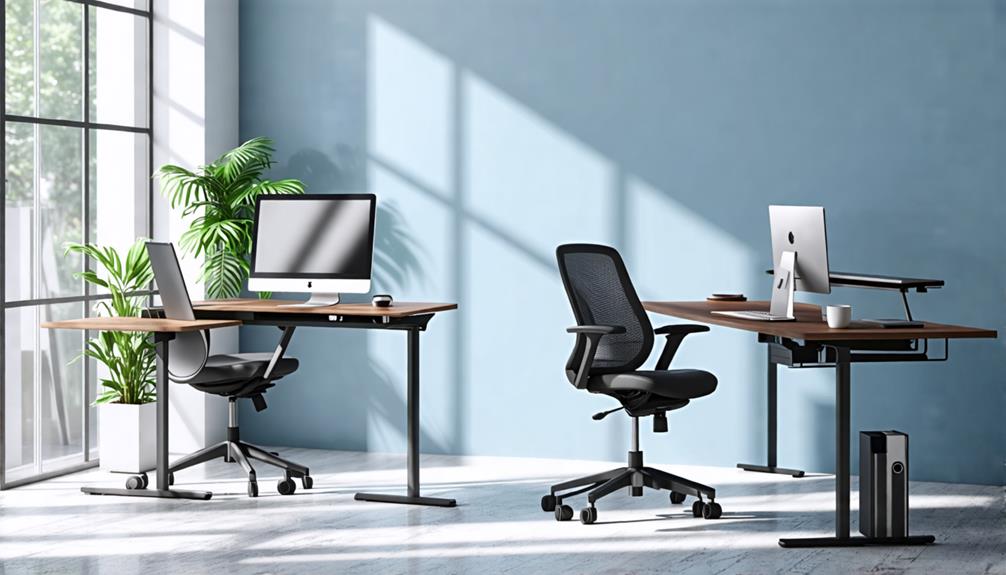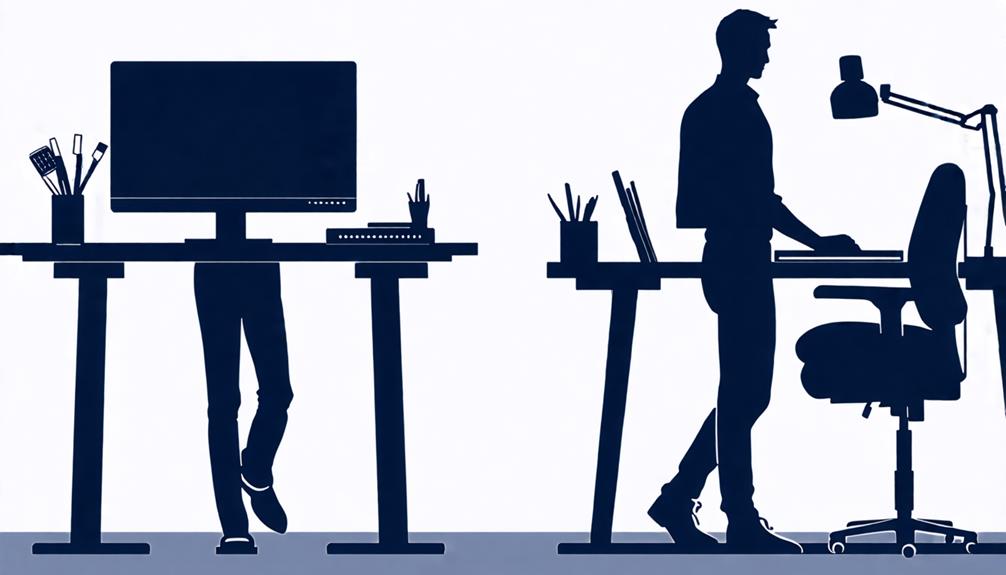Standing Vs Sitting Desk Differences

When it comes to selecting between a standing desk and a sitting desk, you're faced with a decision that can greatly impact both your health and productivity. While sitting has long been the norm, the recent surge in standing desks highlights the wellness risks associated with extended periods spent seated. Standing desks offer a different approach, promising a lower risk of chronic health problems, improved posture, and improved focus. Taking the first step towards integrating movement into your work routine can make all the difference; from here, you can investigate the many ways standing desks can transform your work environment.
The History of Standing Desks

When historians investigate the origins of standing desks, the trail leads back to the 18th century, where remarkable figures like Leonardo da Vinci and Thomas Jefferson pioneered the use of these unique workstations.
Thankfully, you don't have to be a visionary or a founding father to tap into their benefits. Standing desks have had a long, albeit forgotten, history until recently.
In the early 20th century, they gained popularity among professionals and writers who thought that standing while working could improve their productivity and creativity.
Now, with concerns over sedentary lifestyles escalating health impacts, you're part of a growing movement that's rediscovering the standing desk.
Today, sitting
Adjusting the Desk Height

As you set up your standing desk, it's essential to find that perfect balance between standing and sitting.
Adjusting the height of your desk is key to maintaining comfort and avoiding muscle strain. You can start by standing for short periods and gradually increase your time as you become more comfortable.
Make sure to follow some basic guidelines to optimize your ergonomic adjustments and achieve the best experience.
Stand-Sit Balance
To promote a comfortable stand-sit balance, adjustable desks are a vital tool, allowing you to adjust the height for both standing and sitting, guaranteeing ideal ergonomics and comfort throughout the workday.
As someone with a desk job, you know how important it is to find a balance between standing and sitting. Standing desks have numerous health benefits, such as reducing the risk of chronic diseases and improving mental health, but it's just as significant not to stand for extended periods.
Aim to start with 30 to 60 minutes of standing daily and gradually increase this duration to enhance comfort and reduce fatigue. Proper desk height is fundamental, positioning your elbows at 90 degrees when typing while standing and keeping your monitor at eye level to prevent neck strain.
Use reminders or timers to maintain a simple balance between standing and sitting, encouraging movement every 20-30 minutes to improve circulation and minimize discomfort. Regularly assess and adjust your desk setup to guarantee ideal ergonomic alignment and prevent strain during prolonged periods of standing or sitting.
Ergonomic Adjustments
Maintaining proper ergonomic adjustments, particularly with regards to adjusting the desk height, is crucial for comfort and productivity at your workstation. A desk that's too high or too low can lead to discomfort and strain on your neck, shoulders, and back. Finding the right desk height can make a significant difference in your overall working experience.
- Elbow Alignment: Verify that your desk height allows your elbows to rest comfortably at a 90-degree angle. This will help you avoid straining your arms and shoulders.
- Eye Level: Position your monitor so that the top of the screen is at or slightly below your eye level. This will prevent neck strain and confirm you aren't leaning forward.
Reducing Sitting Risks

By now, you're probably aware that prolonged sitting can have long-term health consequences, like heart disease, diabetes, and even certain cancers.
However, there are ways to counteract these risks, even if it simply means getting up from your desk every now and then.
As we investigate the differences between sitting and standing desks, let's look at how reducing sitting time can benefit both your health and productivity.
Health Risks Reduced
Standing at your desk instead of sitting can greatly reduce your risk of chronic health problems. Prolonged sitting has been linked to increased risks of chronic diseases such as type 2 diabetes, heart disease, and certain cancers. Studies suggest that this sedentary behavior can lead to a mortality risk increase of 20-30%. By standing at your desk, you take significant strides in mitigating these health risks.
Here are just a few tangible benefits:
- Reducing the risk of type 2 diabetes: Standing desks can help normalize blood sugar levels post-meal, which is essential for managing this condition.
- Less pain, more comfort: Users of standing desks report a 50% decrease in low back pain compared to those who remain seated for long periods.
Regularly alternating between sitting and standing can help mitigate the negative health effects associated with prolonged sitting, promoting better overall well-being.
Productivity Enhanced
When you switch to a standing desk, your productivity tends to soar due to the natural boost in alertness and energy fostered by increased movement.
The benefits are significant: compared to sitting for prolonged periods, users of standing desks can be up to 46% more productive. This increased productivity stems from a number of factors, including the heightened alertness that comes from regular movement and the absence of discomfort that can impede your focus.
By shifting between sitting and standing, you can maintain your energy levels and combat fatigue, leading to more efficient work.
Furthermore, the portion of your day spent standing and moving around reduces the risks associated with sitting for extended periods, potentially providing long-term health benefits.
Benefits Through Movement

You prolong your life and health by incorporating short periods of movement throughout the day, regardless of whether you're seated or standing. This is becoming increasingly important given the modern lifestyle where sitting is a dominant aspect of daily routines.
For instance, just five minutes of walking every 30 minutes can markedly reduce the harmful effects of prolonged sitting, which includes cardiovascular disease, diabetes, and high blood pressure.
Examples of effective movement habits include:
- Pacing back and forth while on a phone call
- Stretching during commercial breaks while watching TV
These habits improve your productivity and energy levels compared to simply switching between sitting and standing. Even brief periods of standing or walking contribute considerably to better blood sugar regulation after meals, reducing the risk of metabolic syndrome.
The American College of Sports Medicine recommends a minimum of 150 minutes of moderate-intensity physical activity weekly. By making movement a consistent part of your routine, you can offset the negative effects of sedentary behavior and enjoy a healthier, more energetic life.
Taking Care of the Back

To protect your back, it's crucial to shift positions throughout the day, alleviating prolonged pressure on spinal structures that can lead to discomfort and pain.
As you consider using a standing desk, proper ergonomics are critical to minimize back strain. Maintaining a straight head, neck, and spine alignment while standing will help reduce the potential for back pain.
Alternating between sitting and standing can provide significant benefits. A 2018 study demonstrated that users of sit-stand desks experienced a 50% decrease in low back pain.
This underscores the importance of incorporating movement and regular position changes into your routine. Combining these practices with a well-designed standing desk setup can help you prevent musculoskeletal issues associated with both sitting and standing.
Creating a Balance

By incorporating sit-stand desks into your daily routine, you can effectively manage the change between sitting and standing to optimize your comfort and health benefits. A vital aspect of this balance is guaranteeing regular position changes. Research recommends alternating between sitting and standing every 20-30 minutes to improve circulation and metabolic function. This can be as simple as taking a brief walking break or convening standing meetings to keep you moving throughout the day.
Additionally, using ergonomic desks allows for seamless shifts between sitting and standing, reducing discomfort and musculoskeletal issues associated with prolonged positions.
Here's how you can create a balance:
- Take breaks every 30 minutes: Stand up, stretch, and move around to maintain circulation and prevent discomfort.
- Monitor your posture: Guarantee your monitor is at a comfortable height and desk setup to avoid straining your body.
New Growth in Office Ergonomics

Recent trends in office ergonomics emphasize the importance of adjustable sit-stand desks to encourage movement and reduce sedentary behavior among employees. By incorporating these innovative workstations, you can create a healthier and more productive work environment. Changing to standing desks can greatly boost your productivity, particularly in high-interactive settings like call centers, where a 46% increase has been reported.
To maximize the benefits of standing desks, it's essential to also adopt other ergonomic office furniture, such as anti-fatigue mats and proper monitor positioning. This guarantees minimal discomfort and optimizes your overall user experience. Additionally, employers are recognizing the need for workplace policies that promote regular movement. Taking short walking breaks every 20-30 minutes can considerably improve circulation and metabolism.
Effective implementation of sit-stand desk initiatives requires organizational support and clear guidelines to encourage employees to alternate between sitting and standing throughout the day. As you introduce these new ergonomics into your workspace, you can look forward to improving your health, productivity, and overall job satisfaction.
Conclusion
In the fight against prolonged sitting, standing desks are taking the stage.
With a rich history, adjusting desk heights has become essential to reducing sitting risks.
Embracing movement and walk breaks helps keep the blood flowing and relieves back pain.
So, take care of your back by alternating between sitting and standing, embracing the balance our bodies crave.
Leave a Reply